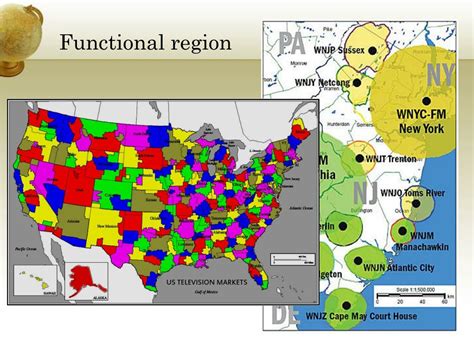Understanding Functional Regions
A functional region, also known as a nodal region, is a geographic area organized around a central hub or node that provides essential services and functions for the surrounding area. This central node could be a city, a major transportation hub, or a center of economic activity.

Characteristics of Functional Regions
- Central Node: The focal point of the region that provides essential services and functions.
- Sphere of Influence: The area surrounding the central node that depends on the node’s services and functions.
- Interdependence: The mutual reliance between the central node and the surrounding area.
- Specialized Role: The central node often specializes in providing specific services or economic activities that are not readily available elsewhere in the region.
Examples of Functional Regions
- Metropolitan Area: A central city and its surrounding suburbs, which rely on the city for employment, education, healthcare, and other essential services.
- Transportation Hub: An airport, port, or major highway interchange that serves as a gateway for people and goods to enter and exit a region.
- Economic Zone: An area designated for specific economic activities, such as manufacturing, tourism, or finance.
- Agricultural Region: A specialized area of agricultural production, such as the Midwest grain belt in the United States.
Importance of Functional Regions
Functional regions play a crucial role in organizing and facilitating human activities:
- Economic Development: Central nodes attract businesses and create employment opportunities, stimulating economic growth in the surrounding region.
- Accessibility and Mobility: Transportation hubs connect people and businesses to distant locations, improving accessibility and mobility.
- Resource Allocation: Functional regions ensure that resources are efficiently allocated to where they are most needed.
- Social and Cultural Exchange: Metropolitan areas foster social and cultural interactions, contributing to a sense of community and belonging.
Applications of Functional Region Concept
The concept of functional regions has been used in numerous applications:
- Urban Planning: Identifying metropolitan areas and their spheres of influence helps planners address issues related to growth, housing, and infrastructure.
- Transportation Planning: Analyzing transportation hubs and their impact on traffic patterns allows for efficient transportation system design.
- Economic Development: Governments and businesses can target investments in economic zones to stimulate economic activity and create jobs.
- Resource Management: Identifying agricultural regions helps allocate resources for sustainable food production and ensure food security.
- Social and Cultural Analysis: Understanding the social and cultural dynamics within metropolitan areas provides insights into urban life and community development.
Tables
Table 1: Examples of Functional Regions
| Type | Central Node | Sphere of Influence |
|---|---|---|
| Metropolitan Area | City | Surrounding suburbs |
| Transportation Hub | Airport | Regional transportation network |
| Economic Zone | Free trade zone | Businesses and industries within the zone |
| Agricultural Region | Farming community | Surrounding agricultural land |
Table 2: Benefits of Functional Regions
| Benefit | Description |
|---|---|
| Economic Development | Attract businesses and create jobs |
| Accessibility and Mobility | Connect people and businesses |
| Resource Allocation | Ensure efficient resource distribution |
| Social and Cultural Exchange | Foster community and interactions |
Table 3: Applications of Functional Region Concept
| Application | Focus |
|---|---|
| Urban Planning | Metropolitan areas and growth management |
| Transportation Planning | Transportation hubs and traffic patterns |
| Economic Development | Investment in economic zones |
| Resource Management | Agricultural regions and food security |
| Social and Cultural Analysis | Urban life and community development |
Table 4: Common Mistakes to Avoid
| Mistake | Description |
|---|---|
| Overlapping Spheres of Influence | Defining functional regions with unclear or overlapping boundaries |
| Lack of Interdependence | Assuming a central node provides services to a region without evidence of actual dependence |
| Unbalanced Development | Ignoring the needs of the surrounding region when focusing on the central node |
| Neglecting Social and Cultural Impacts | Overemphasizing economic benefits while ignoring the social and cultural consequences of functional regions |
Tips and Tricks
- Identify the Central Node: Determine the focal point that provides essential services and functions for the surrounding area.
- Define the Sphere of Influence: Study the patterns of dependence between the central node and the surrounding region.
- Analyze Interdependence: Examine the mutual reliance between the central node and the surrounding area.
- Consider Specialized Roles: Identify the specific services or economic activities that the central node provides.
- Apply the Concept Creatively: Explore innovative ways to use the functional region concept in research, planning, and problem-solving.
Conclusion
Functional regions are essential geographic units that organize human activities and facilitate resource allocation. Understanding the characteristics and applications of functional regions empowers individuals and organizations to make informed decisions, foster economic growth, and enhance the well-being of communities.
